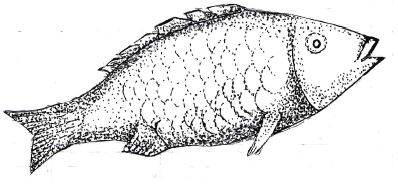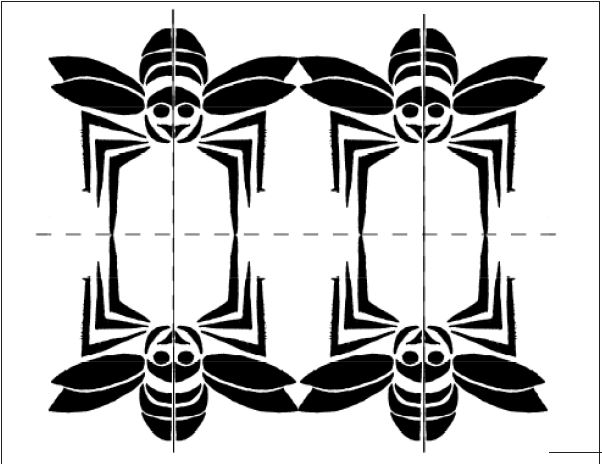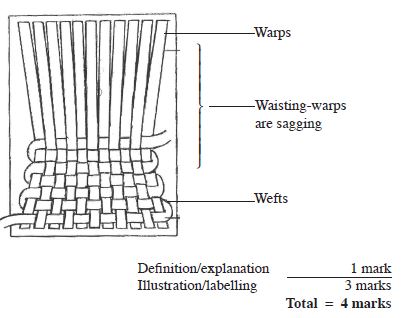QUESTIONS
SECTION A (20 marks)
Answer ALL the questions in this section in the spaces provided.
-
- Study the composition below.
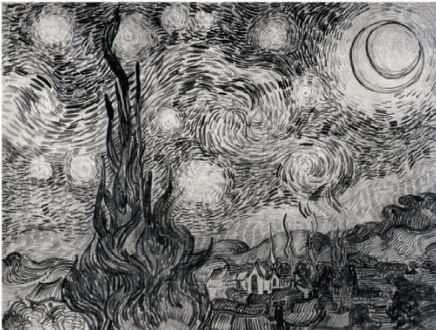
Identify the two most outstanding elements and one principle conveyed in the composition.(3 marks) - Explain the term "pendant" with reference to ornaments.(2 marks)
- Give two basic reasons for decorating fabrics.(2 marks)
- What is the difference between human figure drawing and portraiture?(2 marks)
- State two reasons why a fabric may be crumpled, twisted or plaited when using it to create a collage.(2 marks)
- Study the print below.
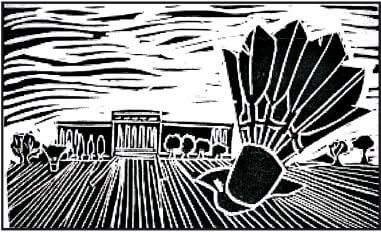
Name the printing technique used to produce it.(1 mark) - Explain the term "priming" and state its function in painting.(2 marks)
-
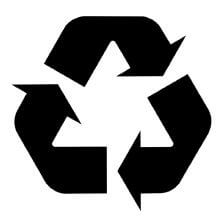
Identify the visual symbol illustrated above and state its function.(2 marks) - Distinguish between the terms hue and pigment.(2 marks)
-
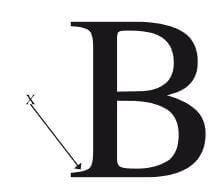
Identify the type face represented by the letter above and name the part labelled X.(2 marks)
- Study the composition below.
SECTION B (25 marks)
Answer ALL the questions from this section in the spaces provided.
- Using the stippling technique, create three dimensional effect on the form illustrated below.(4 marks)
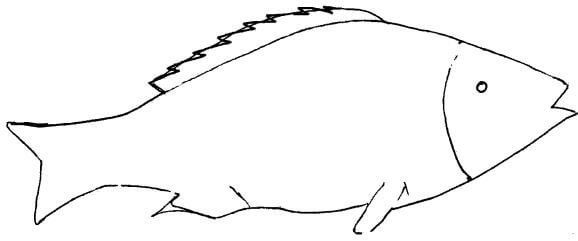
- The illustration below represents a process in the production of an artwork.
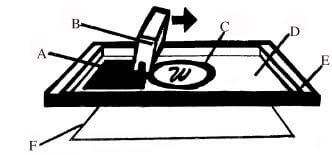
Name the parts labelled A-F and classify them under materials, tools and equipment. (6 marks) - Explain the following techniques of decorating clay articles:
- Incising;(1 mark)
- Slip trailing;(1 mark)
- Inlaying;(1 mark)
- Excising:(1 mark)
- Sgraffito;(1 mark)
- In the space provided, create an inverse repeat pattern using the motif below.(5 marks)
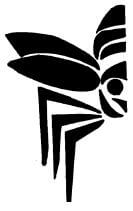
- Read the following statement and rewrite it in calligraphic lettering in the box below.(5 marks)
"A noble character is not inherited,
It is earned by individual effort".
SECTION C (15 marks)
Answer any ONE question from this section. Write your answers in the space provided after question 9.
-
- Name the structure illustrated below and state the material used to construct it.(3 marks)
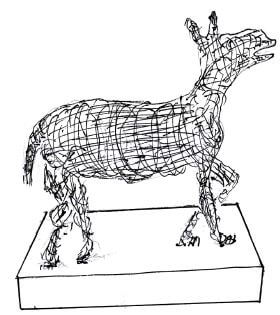
- Describe how you would use the structure to make a form in "papier mache".(12 marks)
- Name the structure illustrated below and state the material used to construct it.(3 marks)
-
- What is a badge?(1 mark)
- Name and explain four components of a badge.(12 marks)
- State two functions of colour in a badge.(2 marks)
-
- With the aid of a labelled illustration describe the term 'waisting' in reference to weaving.(4 marks)
- Explain four ways of achieving firmness of yarn in a mat made using the ghiordes knot.(8 marks)
- State three main ways of finishing a woven mat.(3 marks)
MARKING SCHEME
-
- Texture and line. 2 marks
Rhythm/movement 1 mark 3 marks - A hanging ornamental object suspended from a necklace or earring. 2 marks
-
- To enhance the aesthetic value of the fabric.
- Acts as a symbol/ identity of status role.
- To add economic value to the fabric.
- Communication through pictorial symbols/colour and words.
Any two, 1 mark each = 2 marks
- Human figure drawing is the depiction of a human form, whereas portraiture is a close study / rendition of the characteristics of a specific person from the head to torso/ shoulder. 2 marks
-
- To create textural effect.
- To define form.
- Ti create three dimensional effect.
Any two points 1 mark each. 2 marks
- Block printing / Relief printing (wood block/linoleum). 1 mark
-
- Coating a surface/canvas/fabric with undercoat or primer in preparation for painting. 1 mark
- Function:
- To reduce absorption.
- To stabilise the painting surface/make it stiff or firm/isolates the support (canvas) from damaging ingredients in the paint hence preventing disintegration of the canvas.
- Provides a smooth surface that accepts the paint, letting the paint brush flow better thus adequate adhesion.
Any 1 x 1 = 1 mark
- Eco environment recycle symbol. 1 mark
Function:- Re-use/recycle materials.
- To create awareness on proper use of the environment.
Any 1 x 1 = 1 mark
-
- Hue is another name for colour, used to differentiate one colour from another/it's the attribute of a colour by virtue of which it is discernible as red, green, blue etc.
- Pigment is a natural colouring matter, a powder which is mixed with a solvent (binder) to make paint.2 marks
- Type face: Roman letter.
Part labelled x is Serif. 2 marks
- Texture and line. 2 marks
-
- Stippling technique 1 mark
- Three dimensional effect. 1 mark
- Scales 1 mark
- Fins 1 mark
Total 4 marks
-
6 marksMaterial Tools Equipment A: Ink paste 1 mark B: Squeegee 1 mark E: wooden frame/screen/ metal frame 1 mark F: Printing surface 1 mark C: Design/mofit 1 mark D: Silk mesh 1 mark -
- Incising: Carving/cutting grooves/shapes slightly to create patterns.
- Slip trailing: Application of coloured slip onto an object, then scratch to create designs, marks.
- Inlaying: To set decorative pieces on clay into a clay surface to make a design that is usually level with the surface.
- Excising: cut out/through patterns/designs.
- Sgraffito: Scratch the design on the surface and then apply coloured slip. 1 x 5 = 5 marks
-
Interpretation (inverse) 2 marks
Repeat pattern 2 marks
Execution 1 mark Total 5 marks -
- Interpretation
- Calligraphic characteristics.
- Creativity and aesthetics. 2 marks
- Legibility and readability of letters:
- Uniformity of letters.
- Spacing between letters, words and lines. 2 marks
- Presentation
- Correct copy of statement.
- Neatness. 1 mark 5 marks
- Interpretation
-
-
- Armature: a sculpture framework for supporting the clay or other plastic material in modelling. 2 marks
- Made using thin wire. 1 mark 3 marks
- Process of making a form in "papier mache".
- Collect the required materials, tools and equipment.
- Cut /tear/shred the paper into small pieces.
- Soak in water and leave it to soften and set for at least 3 days.
- Drain the water and add glue or cold water paste.
- Pound into a homogenous pulp/state.
- Apply the pulp in small amounts on to the structure until the entire form is covered.
- Keep building up the form until the desired form/shape is achieved.
- Add details to define the form/shape.
- Refine the details/structure.
- Leave to dry under shade and ensure that it is completely dry.
- Apply the desired colour and leave to dry.
- Apply finish: clear vanish and leave to dry.
Each step 1 x 12 = 12 marks
-
-
- A badge is an identification symbol worn to show membership to a group/organization/ institution, society/rank/position/status/achievement. 1 mark
- Components of a badge:
- Shield:
Main body/overall form/layout of a badge on which the components are arranged/attached (usually oval/round/circular etc). - Identification symbol:
Contains the name and pictorial representation of the institution/rank/status etc. - Ribbon/wreath:
A decorative or beautifully designed section of the badge which bears the motto. - Motto:
A short phrase stating the core values, aspirations or beliefs of an institution.
Stating = 1 mark
Explanation 2 x 4 = 8 marks
Total 12 marks
- Shield:
- Colour function in a badge:
- Aesthetic appeal.
- Identification.
- A symbolic value of what the institution stands for or supports the motto. Any 2 x 1 = 2 marks
-
- Waisting is a defect in a woven article caused by uneven tension of yarn ie. loose warps or tight wefts.
Illustration. - Four ways of achieving firmness of yarn.
- Using thick yarn instead of thin yarn.
- Firmly tying the warp threads to avoid sagging.
- Allowing minimum spacing between the warps.
- Using plain weave after each row of ghiordes knots.
- Pulling the weft threads firmly at the end of each woven line.
- Beating down firmly the weft threads after every row.
Any 4 x 2 marks each = 8 marks
- Three main ways of finishing a woven mat.
- Knotting the warps/fringes.
- Sewing the warps/overcasting/binding.
- Hemming warps/folding and hemming down.1 x 3 = 3 marks
- Waisting is a defect in a woven article caused by uneven tension of yarn ie. loose warps or tight wefts.
Download KCSE 2014 ART & Design Paper 1 Questions with Marking Scheme.
Tap Here to Download for 50/-
Get on WhatsApp for 50/-
Why download?
- ✔ To read offline at any time.
- ✔ To Print at your convenience
- ✔ Share Easily with Friends / Students

